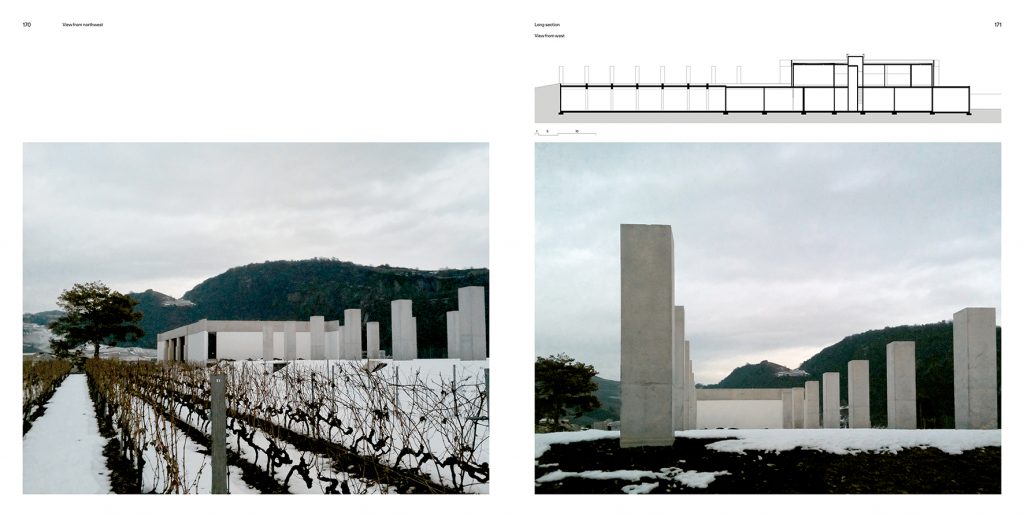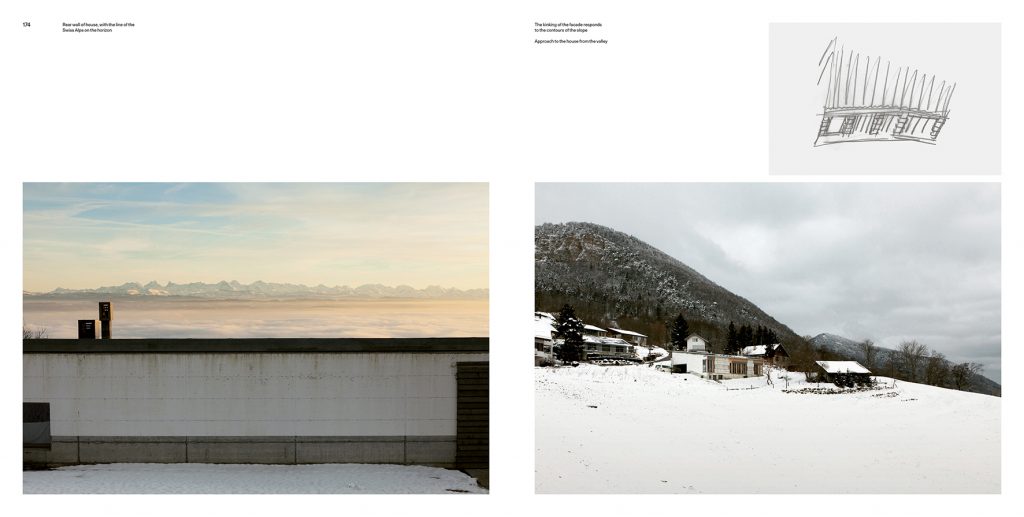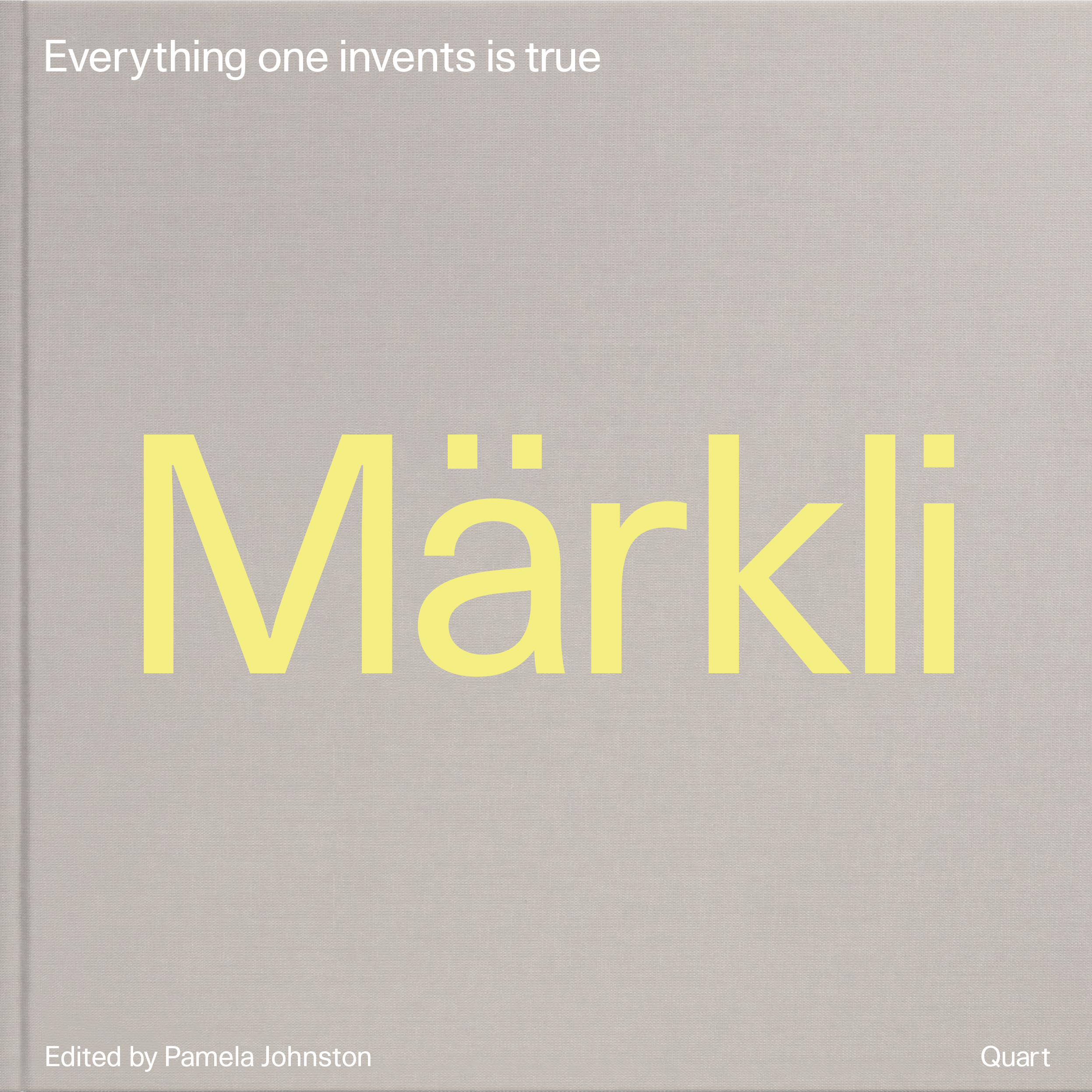Title: Peter Märkli. Everything one invents is true.
Author: Pamela Johnston
Editorial: Quart Publishers, 2017.
Language:
ISBN: 978-3-03761-138-8. English and booklet with essays translations into German.
ISBN 978-3-03761-139-5. English and booklet with projects translations into Japanese. Only under specific demand.
240 pages
***
“And the principles that shape the indivisual houses – a lare living space at the core, designed for conviviality, conversation and views, with the roams requiring more privacy set deeper in the plan – are carried over, in modified form, to the institutional and office buildings. In each case, the plan gives people the means not only to choose the paths they take as they move through the building, but also to create different atmospheres, defined by varying degrees of openness or intimacy. The architect invents an array of posibilities. The inhabitants of the building, in making their choices, in claiming the place as their own, give meaning to this spatial organisation, make it true.
“Y los principios que dan forma a las casas individuales – un espacio vital en el centro, diseñado para la convivencia, la conversación y las opiniones, con las habitaciones que requieren una mayor privacidad en una posición más retirada – se transfieren, en forma modificada, a las instituciones y edificios de oficinas. En cada caso, la distribución en planta brinda a las personas los medios no sólo para elegir los caminos que toman a medida que avanzan por el edificio, sino también para crear diferentes atmósferas, definidas por diversos grados de apertura o intimidad. El arquitecto inventa una serie de posibilidades. Los habitantes del edificio, al hacer sus elecciones, al reclamar el lugar como propio, le dan sentido a esta organización espacial, la hacen realidad.
The search of a new kind of room plan, able to absorb change over time, is a central and continually evolving aspects of Märkli’s practice. From the beginning of hs career he has looked for ways to integrate areas that were once seen as services spaces, but now are lived in: “With each Project you have to look hard at its fundamental components and ask, for example, What is a bathroom? What is a kitchen? If you do not do this, you will end up planning the same old things and you will not be able to suggest any new solutions”
La búsqueda de un nuevo tipo de distribución de espacios, capaz de asumir modificaciones en el tiempo, es un aspecto central y en continua evolución de la práctica de Märkli. Desde el comienzo de su carrera, ha buscado formas de integrar áreas que antes se consideraban espacios de servicios, pero ahora son estancias: “Con cada proyecto, se deben examinar detenidamente sus componentes fundamentales y preguntar, por ejemplo, ¿qué es un ¿baño? ¿qué es una cocina? Si no haces esto, terminarás planificando las mismas cosas antiguas y no podrás sugerir ninguna solución nueva “
Pamela Johnston, Everything one invents is true. Page 6
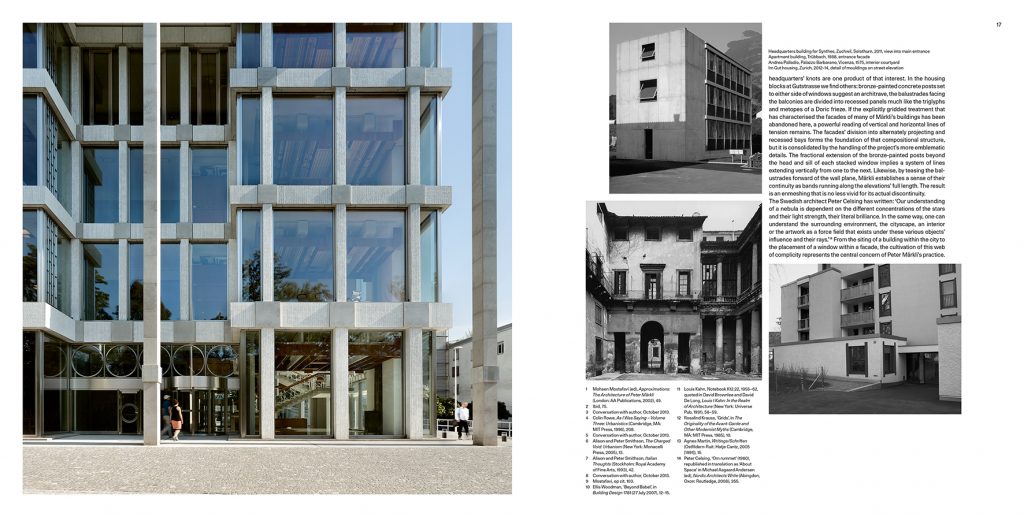
“Whoever you may be as an architect, you are above all a human being living in a certain epoch. You have chices to make. This is right, this is not; I like to be together with people, or to live alone. You cannot choose everything. You also inherit aspects of the past. So your position as an architect involves politics but also a feeling for the eternal. And the eternal makes me hopeful. Here, you have no borders”
“Quienquiera que seas como arquitecto, eres ante todo un ser humano que vive en una época determinada. Debes tomar decisiones. Esto es correcto, esto no lo es; me gusta estar con la gente, o vivir en soledad. No puedes elegir todo. También heredas aspectos del pasado. Entonces, tu posición como arquitecto implica política, pero también un sentimiento por lo eterno. Y lo eterno me da esperanza. Aquí, no tienes fronteras ”
Peter Märkli, 2013
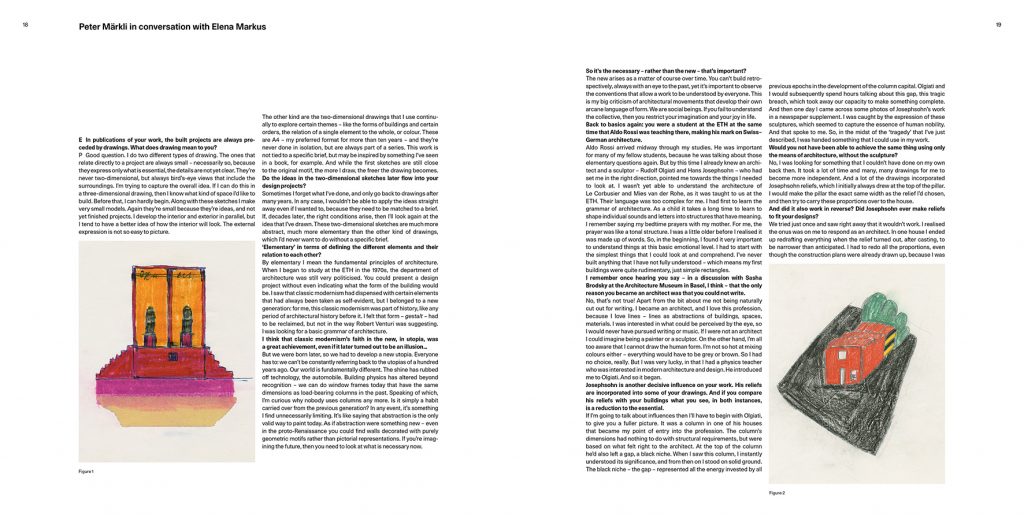
Memories
The first time I came across the name of Peter Märkli was in my second year of Architecture, a little more than 10 years ago. I do not remember exactly the circumstances of that first encounter, but I do remember the impact that in my memory left the reference to the act of experiencing, at a certain moment, a concrete work of Architecture. During some review of of Design, professor Ángel Verdasco related his impressions about a recent visit to La Congiunta, probably the most recognized work of Peter Märkli. This kind of narrative about different projects, always based on a very subjective and circumstantial experience, which is the way in which every person finally interprets any work of Architecture, was very common in that subject. Without the support of images, and without being predetermined by not having previously known the building, the basted words that constructed that brief speech about the act of approaching, entering and walking over the small space dedicated to the sculptural work of the artist Josephson built, perhaps, a first idea of what architecture could mean to me.
La primera vez que me topé con el nombre de Peter Märkli fue en el segundo curso de arquitectura, hace ya algo más de 10 años. No recuerdo con exactitud las circunstancias de aquel primer encuentro, pero sí el impacto que en mi memoria dejó la referencia al acto de experimentar, en un momento determinado, una obra concreta de arquitectura. Durante alguna corrección de la asignatura de proyectos, el profesor Ángel Verdasco relató sus impresiones acerca de una reciente visita a La Congiunta, probablemente la obra más reconocida de Peter Märkli. Ese tipo de narraciones sobre diferentes proyectos, basadas siempre en una experiencia muy subjetiva y circunstancial, que es el modo en que finalmente toda persona interpreta cualquier obra de arquitectura, fueron muy habituales en aquel curso. Sin el soporte de ningún tipo de imagen, y sin estar predeterminado al no conocer previamente el edificio, las palabras hilvanadas que construyeron aquel breve discurso sobre el acto de aproximarse, entrar y recorrer el pequeño espacio dedicado a la obra escultórica del artista Josephson construyeron quizá una primera idea de lo que la arquitectura podía significar para mí.
Without having any book available on the architect’s work, I searched on the internet for some images that could give us some clues about Märkli’s work. I remember that the apparent simplicity of the work depicted by few images of poor quality me surprised me greatly. At that time I was not able to understand or find a relationship between an oral discourse of such a rich architectural experience and those small naked spaces, devoid of practically any element or meaning except its own essence. I remember finding details that moved me, provoking in me some uneasiness. The elongated mass of concrete raised in a deep valley, far from all logic in its relationship with the place. The superposition of a structure of industrial-like skylights below the naked volume of concrete. The access, a small door devoid of any ritual idea of monumentality that seems to warn of the transcendence implied by the act of crossing it. Concatenateds interiors, of a brutally raw, where the presence of the different reliefs hanging from the walls distort the scale of the spaces. A heavy light that freezes the passing by. At last, an Architecture of humble appearance that was capable of emotionally hitting everyone who experienced it or, like me, imagined doing it.
Sin tener al alcance ningún libro sobre la obra del arquitecto, busqué con un compañero en internet algunas imágenes que nos pudieran dar alguna pista sobre la obra de Märkli. Recuerdo que la aparente sencillez de la obra que pocas imágenes de mala calidad me mostraron me sorprendió enormemente. En ese momento no fui capaz de comprender ni hallar relación entre un discurso oral de una experiencia arquitectónica tan rica y aquellos pequeños espacios desnudos, desprovistos prácticamente de todo elemento o significado salvo su propia esencia. Recuerdo encontrar detalles que me conmovieron provocando en mi cierta inquietud. La alargada figura de hormigón levantada en un profundo valle, lejos de toda lógica en su relación con el lugar. La superposición de una estructura de lucernarios de aspecto industrial sobre el volumen desnudo de hormigón. El acceso, una pequeña puerta desprovista de cualquier idea ritual de monumentalidad que parece avisar de la trascendencia que implica el acto de atravesarla. Unos interiores concatenados, de una crudeza brutal, donde la presencia de los distintos relieves que cuelgan de los muros distorsionan la escala de los espacios. Una luz pesada que congela el discurrir del tiempo. Al fin, una arquitectura de apariencia humilde que era capaz de golpear emocionalmente a todo aquel que la experimentaba o, como yo, imaginaba hacerlo.
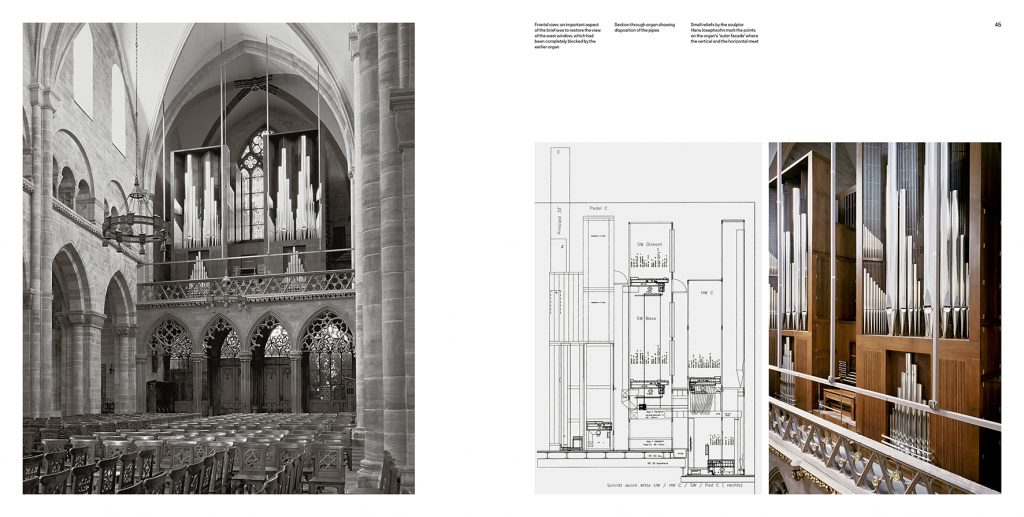

The Grid
Time has passed by from that first meeting with Peter Märkli until nowadays, when we read the most recent monograph on his work: “Peter Märkli. Everything one invents is true “. The imposing book, both by size and appearance, has been edited by Pamela Johnston for Quart Publishers Ltd Lucerne, Swiss publishing house established in Luzern.
Tiempo ha pasado de aquel primer encuentro con Peter Märkli hasta este momento presente, en que tenemos entre manos la monografía más reciente sobre su obra: “Peter Märkli. Everything one invents is true”. El imponente libro, por tamaño y aspecto, ha sido editado por Pamela Johnston para Quart Publishers Ltd Lucerne, editorial suiza establecida en Luzern.
In its almost 250 pages, this monograph shows the production of Peter Märkli’s office over the last decade, with the exception of an unbuilt project in the Dominican Republic in the early 1990s. The most of the fifteen projects published share a characteristic. Except for two works, the rest are built projects. The fact of having discarded the publication of projects in process or competitions could give us some clue about one of the possible fundamental criteria that govern the monograph. To understand the architectural practice of Peter Märkli is essential to approach it through the whole process that begins in very personal drawings about compositions or architectural elements, often initiated independently of the projects and as autonomous research, and ends in the careful definition of each one of the interior details of the building. This process also sometimes includes the design of furniture, as well as the collaboration with different artists that will add more layers of complexity to an architecture already loaded with moments and possible interpretations.
En sus casi 250 páginas, esta monografía nos muestra la producción de la oficina de Peter Märkli a lo largo de la última década, a excepción de un proyecto no ejecutado realizado en República Dominicana a principio de los 90. Los 15 proyectos que aquí aparecen publicados presentan en su mayoría una característica en común. Salvo dos obras, el resto son proyectos construidos. El hecho de haber obviado o descartado la publicación de proyectos en proceso o concursos puede darnos alguna pista sobre uno de los posibles criterios fundamentales que rigen la monografía. Para comprender la práctica arquitectónica de Peter Märkli es fundamental acercarse a ella recorriendo todo el proceso completo que se inicia en dibujos muy personales sobre composiciones o elementos arquitectónicos, iniciados muchas veces de manera independiente a los proyectos y como investigaciones autónomas, y termina en la cuidada definición de cada uno de los detalles interiores del edificio. Este proceso incluye a veces también el diseño de mobiliario, así como la colaboración con diferentes artistas que añadirán más capas de complejidad a una arquitectura ya de por sí cargada de momentos y posibles interpretaciones.
These projects are accompanied by four critical texts and a short interview with the architect. Although most of them focus mainly on the very recent works, with the exception perhaps of that written by Franz Wanner that shows a splendid interpretation of La Congiunta, the reading of these articles is a fundamental exercise to approach the constructed thought of Peter Märkli. Sadly we find ourselves on many occasions with supposedly critical texts that do not contribute anything to the monographs that include them and, what is worse, to the works of the authors that they intend to describe. Happily, his is not the case. The level of each of the texts is simply oustanding. Reading them over and over again, as one goes through the built work of Märkli, will be a real pleasure and will serve as main support to make different readings of each of the projects.
Estos proyectos se acompañan de cuatro textos críticos y una pequeña entrevista al arquitecto. Aunque en su mayoría se centren fundamentalmente en las obras más recientes, a excepción quizá de áquel escrito por Franz Wanner que muestra una espléndida interpretación de La Congiunta, la lectura de estos artículos supone un ejercicio fundamental para acercarse al pensamiento construido de Peter Märkli. Tristemente nos encontramos en muchas ocasiones con textos presuntamente críticos que no aportan nada a las monografías que los incluyen y, lo que es peor, a las obras de los autores que pretenden describir. No es este el caso. El nivel de cada uno de los textos es sencillamente excepcional. Leerlos una y otra vez, a medida que se recorre la obra construida de Märkli, supondrá un verdadero placer y servirán de soporte fundamental para poder realizar distintas lecturas de cada uno de los proyectos.
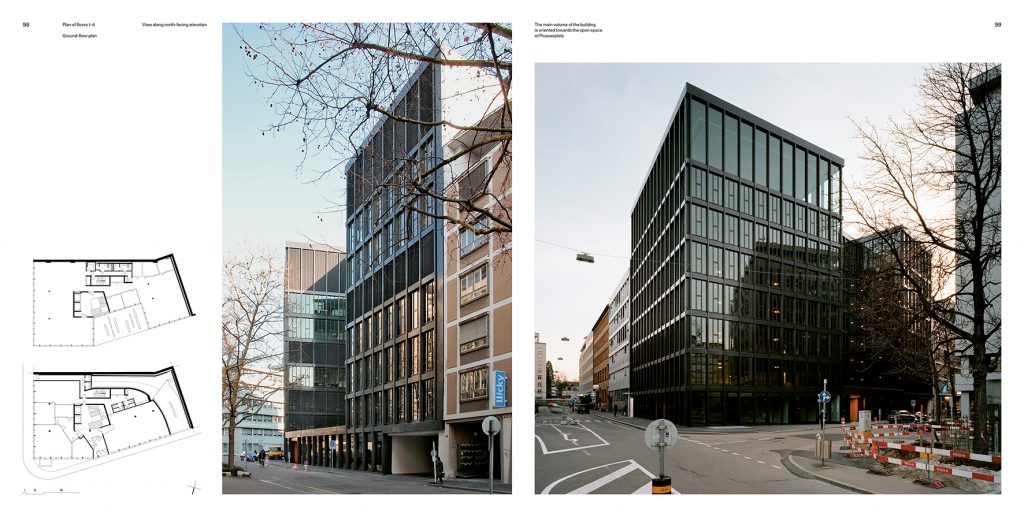
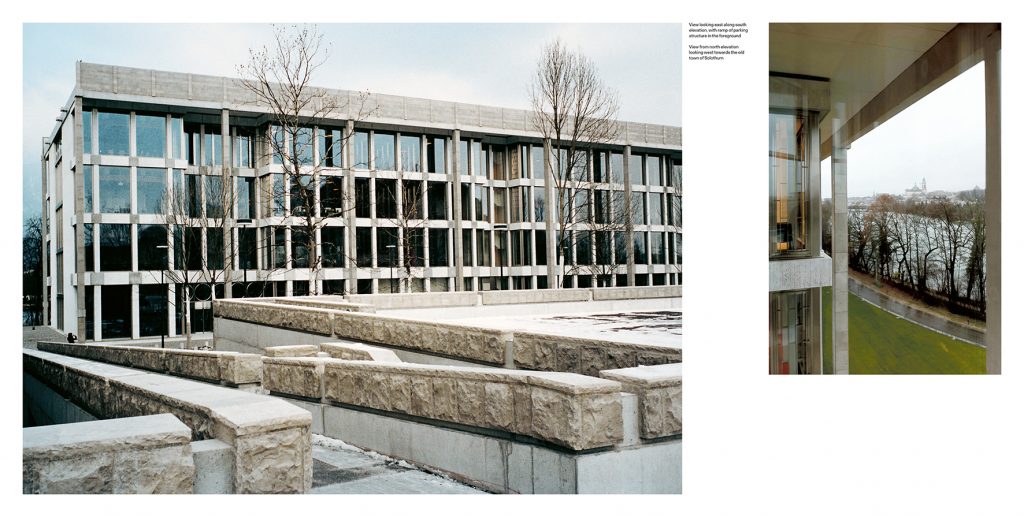
The Knots
The texts that appear in Peter Märkli’s monograph are not the work of only different critics. In addition, we will find brief articles by the architect himself who will structure the group of works presented from common concepts. Thus, the 15 works featured will be shown in five groups initiated by the personal explanation of the architect on a specific topic. Through these inspiring texts we will better understand some of the concerns and, above all, the ideological approaches of an architect really committed to society and to the honest practice of architecture. The writing method of Peter Märkli is appreciably didactic and, far from making an attempt to theorize with an academic vocation, he discovers us by using an almost literary narrative part of his world of experience and references. These will always orbit around themes very present in his work, such as the idea of the common and the collective, the firm commitment to a dense city conceived from the public, a complex reinterpretation of modernity and Western classicism from a critical insight very supported by the strength of the closest context, or its personal approach to a materiality that, using humble techniques and materials, tries to construct transcendental frameworks for the development of a dignified life.
Los textos escritos que aparecen en la monografía de Peter Märkli no son obra solamente de distintos críticos. Además, encontraremos breves artículos del propio arquitecto que estructurarán el grupo de obras presentadas a partir de conceptos comunes. Así las 15 obras expuestas se mostrarán en cinco grupos iniciados por la personal exposición del arquitecto sobre un tema determinado. A través de estos inspiradores textos conoceremos mejor algunas de las preocupaciones y, sobre todo, los planteamientos ideológicos de un arquitecto realmente comprometido con la sociedad y con la práctica honesta de la arquitectura. El método de escritura de Peter Märkli es apreciablemente didáctico y, lejos de realizar un intento de teorizar con vocación académica, nos descubre haciendo uso de una narrativa casi literaria parte de su mundo de experiencia y referencias. Éstas orbitarán siempre alrededor de temas muy presentes en su obra, como pueden ser la idea de lo común y lo colectivo, la apuesta firme por una ciudad densa planteada desde lo público, una compleja reinterpretación de la modernidad y el clasicismo occidental desde una postura crítica muy apoyada en la fuerza del contexto más próximo, o su personal aproximación a una materialidad que usando técnicas y materiales humildes intenta construir marcos trascendentes para el desarrollo de una vida digna.
By reading these short texts we believe we fully understand the editorial intention of “Peter Märkli. Everything one invents is true “. The way in which the different elements that compose the monograph are presented, whether graphic or written, construct a clear, legible and well-ordered structure. At the same time, there are brief interstitial moments that open with more freedom transversal ways that complete the understanding of Märkli’s works, especially by his own words. According to our point of view, the edition of the book is an absolute success, since it accompanies very easily the special character of the architect’s work. It is not usual to find books whose presentation or speech support so widely the work of the author that they intend to expose. As we have been completing their reading, we have been really aware that the position or design of each element has been made from a general idea of how Peter Märkli’s work should be showed on a finite and closed medium such as a book.
Es mediante la lectura de estos breves textos cuando creemos comprender plenamente la intención editorial de “Peter Märkli. Everything one invents is true”. La forma en que se presentan los distintos elementos que componen la monografía, ya sean gráficos o escritos, construyen una estructura clara, legible y ordenada. Al mismo tiempo, se da lugar a breves momentos intersticiales que con mayor libertad abren vías transversales que completan la lectura sobre la obra de Märkli, especialmente en la compañía de sus propias palabras. Según nuestro punto de vista, la edición del libro es un absoluto acierto, pues acompaña con mucha facilidad el especial carácter de la obra del arquitecto. No es habitual encontrarse con libros cuya presentación o discurso estén tan en sintonía con la obra del autor que pretenden exponer. A medida que hemos ido completando su lectura, hemos sido realmente conscientes de que la posición o diseño de cada elemento se ha hecho desde una idea general de cómo se debe exponer la obra de Peter Märkli en un medio finito y cerrado como es un libro.
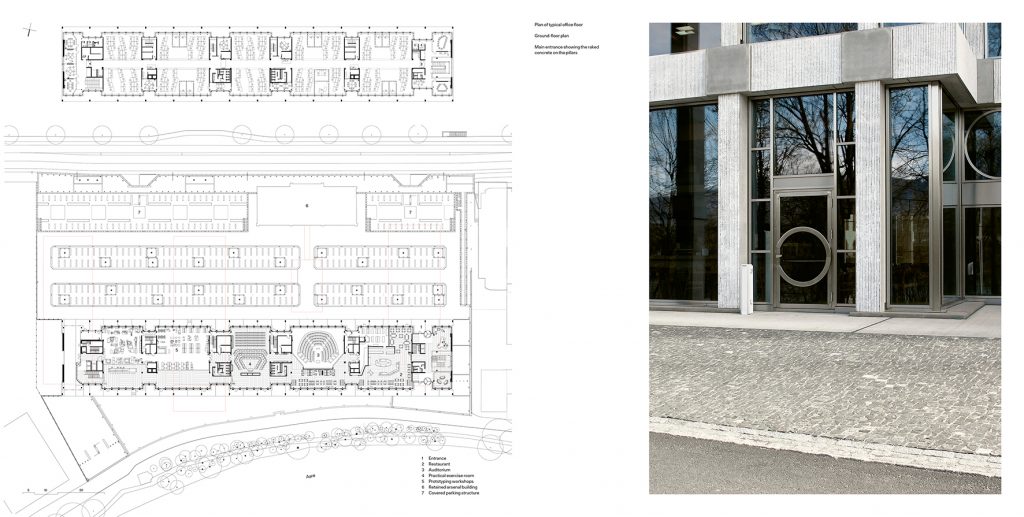
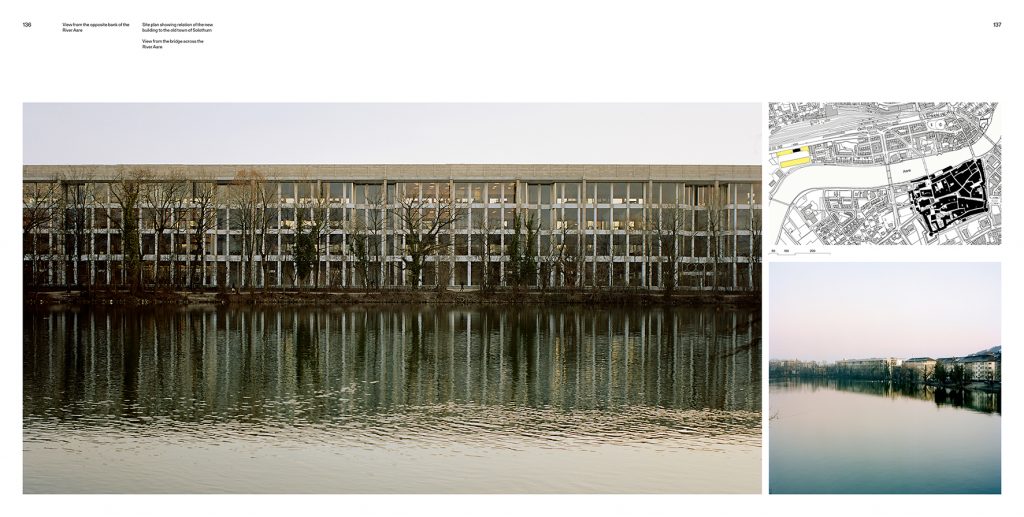
Atmospheres
To conclude, we would not be able to add much more about “Peter Märkli. Everything one invents is true “but the fact that has been a fantastic experience and a great opportunity to learn more about the essential practice of such a necessary architect.
Para concluir, poco más podríamos decir aparte de que la lectura de “Peter Märkli. Everything one invents is true” ha sido una experiencia fantástica y una gran oportunidad para conocer más a fondo la práctica imprescindible de un arquitecto tan necesario como Peter Märkli.
It is true that the monograph is not cheap, even more expensive than the usual average of this kind of books. And one could also argue that it is not the definitive monograph on Peter Märkli, because we will not find in it the first decades of his work, nor of course the decades that are to come. However, it is, without any doubt, a fundamental and essential book, simply wonderful, for every current practitioner or amateur to the architectural practice. The careful graphic design of each element of the book, from the cover material to the chosen typography or the selected graphic documents, as well as the outstanding articles that accompany the work of Märkli, create the ideal framework for the adventure of trying to understand and give context to his practice. An honest and humanistic practice, as already stated, absolutely necessary in these rushed times when it is difficult to find strongholds of resistance that give us hope to imagine still another possible world. A world built from the transcendence of the collective.
Es cierto que la monografía tiene un precio elevado, superior a la media habitual de este tipo de libros. Y también se podría argumentar que no se trata de la monografía definitiva sobre Peter Märkli, pues no encontraremos en ella las primeras décadas de trabajo del arquitecto, ni por supuesto las décadas que están por venir. Sin embargo es, sin ningún género de duda, una obra fundamental e imprescindible para cualquier arquitecto que ejerza hoy en día o, simplemente, para cualquier aficionado a la práctica arquitectónica. El cuidado diseño gráfico de cada elemento del libro, desde el material de portada hasta la tipografía escogida o los documentos gráficos que se muestran, así como el altísimo nivel de los artículos críticos que acompañan la obra de Märkli construyen el marco idóneo para la aventura que supone tratar de conocer y contextualizar su práctica. Una práctica honesta y humanista, como ya quedó dicho, absolutamente necesaria en estos tiempos apresurados donde es difícil encontrar focos de resistencia que nos den esperanza en imaginar aún un mundo posible construido desde la trascendencia de lo colectivo.
